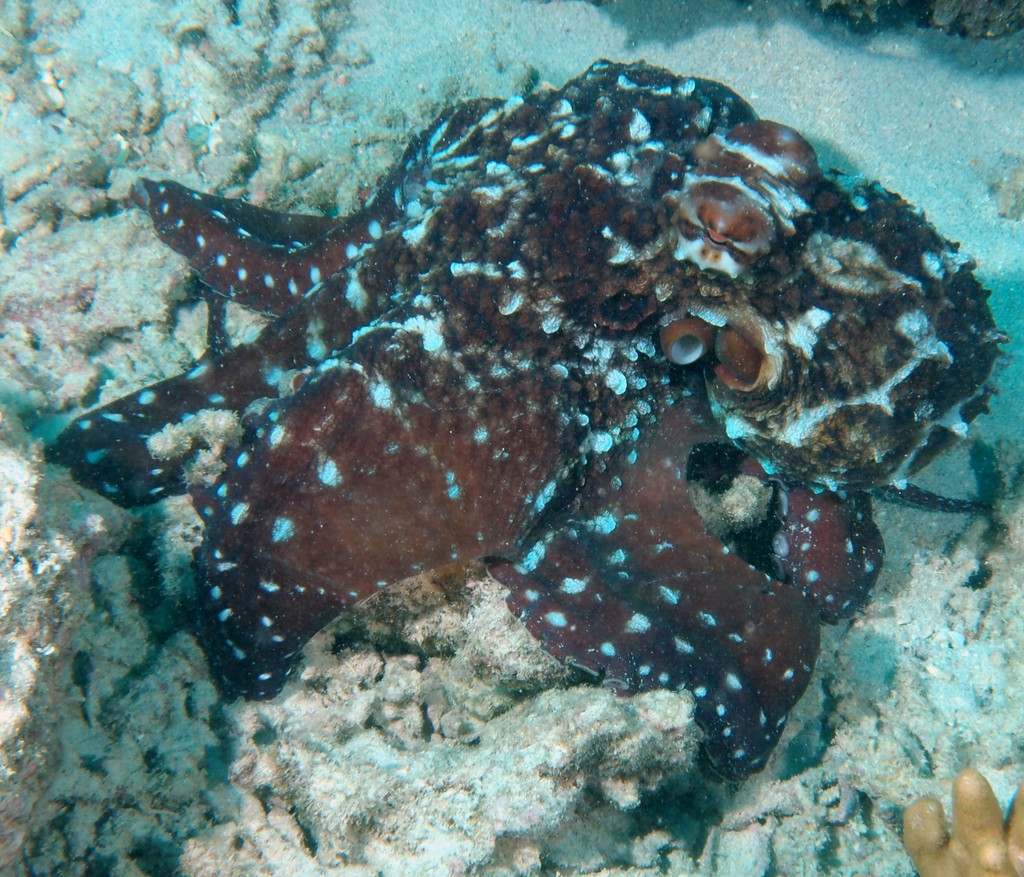OCTOPUS CYANEA - (GRAY, 1849)
Mollusca (Phylum) > Cephalopoda (Class) > Coleoidea (Subclass) > Octopodiformes (Superorder) > Octopoda (Order) > Incirrata (Suborder) > Octopodoidea (Superfamily) > Octopodidae (Family) > Octopus (Genus)
Gros poulpe bleu, Poulpe de récif, Big blue octopus, Cyane's octopus, Day octopus, Krake, Polpo indopacifico, Pulpo azulón,
L'Octopus cyanea est un poulpe vivant dans les eaux tropicales de l'océan Pacifique et de l'océan Indien.
Synonymes
Callistoctopus magnocellatus (Taki, 1964)
Octopus cyanea var. gracilis (Robson, 1929)
Octopus cyaneus (Gray, 1849)
Octopus glaber (Wülker, 1920)
Octopus herdmani (Hoyle, 1904)
Octopus horsti (Joubin, 1898)
Octopus marmoratus (Hoyle, 1885)
-----------------------------------------
Description
Octopus cyanea is a large octopus which is active during the day. Although it is capable of quick colour changes it is usually observed as dark brown to purple in colouration with white spots. Depending on its colour sometimes a dark false eye spot can be seen. As an expert hunter they have been known to throw their arms over a whole head of coral, using the end of their tentacles to herd the fish out in to its waiting beak. Some cases of sexual cannibalism have been observed but do not appear to be a common act with this species.
A large octopus. Mantle round to oblong, smooth-skinned (non-papillose) with a few large tubercles; one large cirrus over each eye, usually with 2 secondary, smaller tubercles; a dark purplish, ringed ocellus or “eye spot” located on web on each side between the eye and the base of arms III and IV. Arms stout, robust, coequal, arms IV slightly longer; right arm III hectocotylized: calimus and ligula very small (0.4 to 1.4% of arm length); ligula groove shallow with about 10 often obscured transverse ridges; About 10 filaments on outer demibranch of gill. Colour : mantle mottled, reticulate, arms with purple-brown blotches.
Octopus cyanea grows to 16 cm in mantle length with arms to at least 120 cm. Max. published weight: 4.0 kg.
Etymology
The type specimen was collected off Australia and is deposited at The Natural History Museum in London.
Distribution
It occurs in both the Pacific and Indian Oceans, from Hawaii to the eastern coast of Africa. Reported from New Caledonia.
Biotop
A benthic species occurring in shallow waters on coral reefs. Unlike many other octopuses, it hunts during daylight hours.
Gros poulpe bleu, Poulpe de récif, Big blue octopus, Cyane's octopus, Day octopus, Krake, Polpo indopacifico, Pulpo azulón,
L'Octopus cyanea est un poulpe vivant dans les eaux tropicales de l'océan Pacifique et de l'océan Indien.
Synonymes
Callistoctopus magnocellatus (Taki, 1964)
Octopus cyanea var. gracilis (Robson, 1929)
Octopus cyaneus (Gray, 1849)
Octopus glaber (Wülker, 1920)
Octopus herdmani (Hoyle, 1904)
Octopus horsti (Joubin, 1898)
Octopus marmoratus (Hoyle, 1885)
-----------------------------------------
Description
Octopus cyanea is a large octopus which is active during the day. Although it is capable of quick colour changes it is usually observed as dark brown to purple in colouration with white spots. Depending on its colour sometimes a dark false eye spot can be seen. As an expert hunter they have been known to throw their arms over a whole head of coral, using the end of their tentacles to herd the fish out in to its waiting beak. Some cases of sexual cannibalism have been observed but do not appear to be a common act with this species.
A large octopus. Mantle round to oblong, smooth-skinned (non-papillose) with a few large tubercles; one large cirrus over each eye, usually with 2 secondary, smaller tubercles; a dark purplish, ringed ocellus or “eye spot” located on web on each side between the eye and the base of arms III and IV. Arms stout, robust, coequal, arms IV slightly longer; right arm III hectocotylized: calimus and ligula very small (0.4 to 1.4% of arm length); ligula groove shallow with about 10 often obscured transverse ridges; About 10 filaments on outer demibranch of gill. Colour : mantle mottled, reticulate, arms with purple-brown blotches.
Octopus cyanea grows to 16 cm in mantle length with arms to at least 120 cm. Max. published weight: 4.0 kg.
Etymology
The type specimen was collected off Australia and is deposited at The Natural History Museum in London.
Distribution
It occurs in both the Pacific and Indian Oceans, from Hawaii to the eastern coast of Africa. Reported from New Caledonia.
Biotop
A benthic species occurring in shallow waters on coral reefs. Unlike many other octopuses, it hunts during daylight hours.
